



In various domains, such as movies, music, books, and TV, the amount of content is increasing rapidly. Although this vast content provides a wide range of choices to users, they often have difficulty with choosing or finding what they want to consume due precisely to this huge amount of content. For this reason, researchers have proposed various recommendation systems for providing convenience in choice [1-7] and these recommendation systems are successful in various services, such as movies, music, and e-commerce [8]. Some services are for single users and some for group users. For example, e-commerce services are usually for single users, and movies or TV programs are for single or group users. However, most recommendation approaches are designed for single users and there are only a small number of approaches for group users.
General group recommendation systems need to model the preference of groups for the recommendation. There are two main approaches. The first is the group profile-based approach. If there is a group of users
Because group profile-based approaches are very similar to recommendations for single users, most approaches for single users can be directly applied and do not have many variants. On the other hand, many consensus function-based approaches have been proposed. McCarthy and Anagnost [8] proposed a group preference arbitration system. It merged group member preference into a preference and recommended pieces of music that the group would like to listen to. Boratto and Carta [10] proposed how to make synthetic virtual group users by using clustering and then applied several consensus functions to a movie domain. Baltrunas et al. [11] proposed a group recommendation system using rank aggregation. In order to build preferences of group users, it used ranks instead of ratings. This method was applied to a movie domain [11]. Gorla et al. [13] proposed a probabilistic group recommendation via information matching. It made a group user preference model from each member’s preference, based on probability. In addition, it applied to a movie domain.
Researchers evaluate and verify group recommendation approaches, however, with synthetic or limited datasets [8-16] because real large-scale datasets of group profiles are rare. Regarding design group recommendation systems, we need to consider group and domain characteristics simultaneously. Group user characteristics may change, depending on domain characteristics [12]. For example, we could ignore minor opinions in a group on casual domains, such as movies or TV programs.
In addition, to provide recommendation in many domains, we need to consider making user profiles use general recommendation methods. The general recommendation methods use the users’ profiles, such as rating. In many domains, however, it is difficult to collect the user rating information because of lack of interaction or additional cost. Therefore, we need to consider basing the user profiles on consumed histories.
In this paper, we make users’ profiles from users’ consumed histories and analyze the effectiveness of group recommendation systems on real large-scale datasets regarding TV domain. In addition, we provide some guides for group recommendation systems, focusing on home group users in TV domains. We have organized the remainder of this paper as follows. Section 2 overviews methods for group modeling. Section 3 describes real-world datasets and pre-processing. Section 4 presents experimental results and Section 5 provides conclusions.
To suggest items to a single user, most recommendation systems adopt a simple approach based on user profiles, such as ratings on items. For example, if a target user has high ratings on the items
Unlike the recommendation system for single users, the group recommendation system needs consideration of the group profile and the group members’ profile together.
There are two major approaches for group recommendations: the group profile-based approach and the consensus function-based approach. Each approach uses only one type of profiles, group profiles or group member profiles. The following paragraphs provide details on this approach.
2.1 Group Profile-Based Approach
The group user approach makes group profiles from group histories only. In other words, this approach treats a group as a single user. For example, there is a group user
2.2 Consensus Function-Based Approach
In the case where group profiles are hard to obtain but group members’ profiles are available, the consensus function approach can be applicable. These approaches make a group profile from group members’ profiles by using consensus functions. The consensus functions merge group members’ profiles into a pseudo-group profile and the profile is used to recommend. There are various consensus function strategies, such as least misery, most pleasure, and average. These consensus functions imitate decision making processes in the group [9]. The pseudo-group profiles that are made by each consensus function have difference characteristics, leading to different performances of the group recommendation system. Let us assume that there are group members’ profiles as follows:
2.2.1 Least misery strategy
The least misery strategy (
The recommendation system could avoid suggesting TV programs that are similar to
2.2.2 Most pleasure strategy
The most pleasure strategy (
The recommendation system could suggest TV content, such as TV programs similar to
2.2.3 Average strategy
The average strategy (
The recommendation system could suggest TV content, such as items similar to
2.3 Consensus Function with Group Profile-Based Approach
In the case where both group profiles and group members’ profiles are available, the consensus function with group profile based approaches can be applicable. The approach makes pseudo-group profiles from group profiles and group members’ profiles. This approach is an extension of the previously mentioned consensus function-based approach. Let us assume that there are a group profile and group members’ profiles as follows:
Then,
This approach considers group preferences and group members’ preferences simultaneously. However, this approach could be suitable when we know the agreement process among the group members and select an appropriate consensus function.
In order to make group profiles, we should consider when we apply the collaborative filtering to predict unknown ratings [12]. To make group profiles, we can apply the collaborative filtering before or after applying the consensus function-based approach and the consensus function with group profile-based approach. If a collaborative filtering is applied first, recommendation lists for each group members are generated and then the recommendation list for the group is generated by a consensus based approach. Therefore, the recommendation list for the group may reflect more each group member’s preference. If a consensus function-based approach is applied first, the pseudo-group profiles are made from the group members’ profiles by a consensus based approach, and then the recommendation list for the group is generated by applying a collaborative filtering to the pseudo-group profile. Therefore, this approach may reflect more of the group preference, or the consensus between group members.
In order to analyze the performance of the group recommendation systems, we use the TNmS dataset. TNmS is the company that collects users’ watching histories and provides program rating information. To collects the users’ watching histories, TNmS uses the devices (peoplemeter) that are set on the panel homes. The TNmS dataset consists of users’ watching histories from 1,000 homes in Korea between 1/1/2013 and 6/30/2013. The number of total personal users is 3,318, with total TV content at 107,570. This TV content is on four public channels (KBS1, KBS2, MBC, and SBS). If a user watches TV content for less than 15 minutes, it is regarded as an invalid view and ignored.
Table 1 shows information of the dataset. In Table 1, groups have fewer watching histories than single users. Furthermore, about 50% of groups have fewer than 25 histories.
[Table 1.] Dataset information

Dataset information
In order to apply the previously mentioned approaches, ratings on the TV program should be made from watching histories. We use the following equation.
In Eq. (7),
We experiment with five types of group recommendation systems. The first is the group profile-based approach (
We use the user-based collaborative filtering to predict ratings. In collaborative filtering, we use the Pearson correlation coefficient to calculate similarity between users. It is as follows:
In Eq. (8),
In Eq. (9), is the predicted rating on item
The dataset is divided into a training set and a testing set. The training set is first the 80% watching histories and the other 20% of watching histories were used as the testing set. The number of TV programs in the testing set is 133,383.
The recommendation process is as follows. If there is a group user with a test item, the recommendation system finds the existing ratings or predicts the unknown ratings on available TV programs by using the group user’s profile or the pseudo-group profile. A TV program with the highest rating is then offered to the group user.
In order to analyze performances of the group recommendation systems, we use precision as a metric. It is defined as follows:
The number of correctly recommended TV programs is the number of programs viewed by users in the recommended TV programs. If the value of the precision is higher, it means that the group recommendation system has a higher performance.
In this section, we analyze the experimental results in two aspects. The first is the overall comparison of performance between each group recommendation system. The second is the performance depending on history sizes.
4.3.1 Overall comparison of performance
Table 2 shows the performance of various group recommendation approaches. First,
[Table 2.] Overall performance comparison

Overall performance comparison
4.3.2 Comparison of performance depending on history size
Figures 1-3 show performances of various group recommendation systems depending on the history sizes of the groups. We do not compare with the experiment results of
First, Figure 1 shows the performance of
When a group has more than 300 histories, the performance of
Second, Figure 2 shows the performance of
Last, Figure 3 shows the comparison of the
These results tell us which approach is better depending on available information. If the system cannot use group profiles,
In this study, we evaluated various group recommendation approaches with a real-world dataset, and provided some guidelines for group recommendation systems, focusing on home group users in TV domains.
We evaluated the five types of approaches:
The performance of the
For a better recommendation, we may use profiles of groups with preferences that are similar to those of target groups. In future work, we will extend group recommendation approaches with similar group profiles and more various consensus functions.














